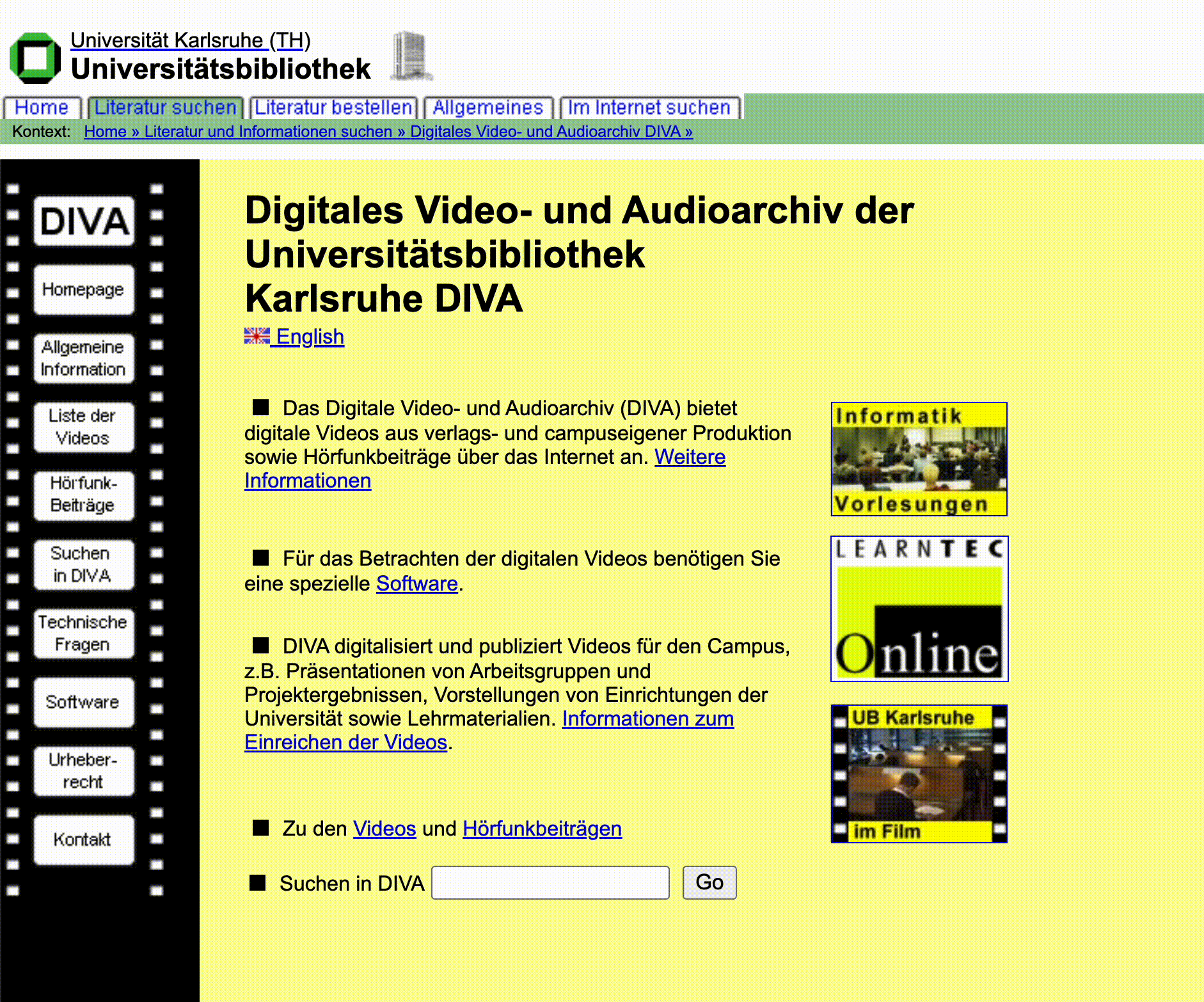![]() Would you like to
have this page translated automatically? Then click on the link below to download data from the external Google Translate Server. Note: Personal data
(e.g. your IP address) will be transmitted to this server. Google Translate now ...
Would you like to
have this page translated automatically? Then click on the link below to download data from the external Google Translate Server. Note: Personal data
(e.g. your IP address) will be transmitted to this server. Google Translate now ...
The KIT Library Media Portal celebrates its 25th anniversary

In May 2000, "DIVA", the digital video and audio archive of the Karlsruhe University Library (now KIT Library), went online for the first time. Under the name "KIT Library Media Portal", this service is still the central platform for all in-house audiovisual productions at KIT. To commemorate this anniversary, we would like to outline the history of the service in more detail in this article.
DIVA was originally part of a larger project to modernize the libraries in Baden-Württemberg, in particular as part of the "Zukunftsoffensive Junge Generation" (Young Generation Future Initiative), which had been running since 1997. This initiative provided over 40 million German marks for the modernization of libraries in the state, and Karlsruhe University Library was part of the multimedia working group involved in this project. The funding enabled the development and operation of DIVA as part of the library's digital infrastructure.
The aim of DIVA was to archive and provide video and audio files produced on campus, in particular lecture recordings, scientific presentations and media from radio and television. The service would also enable the creation of interactive multimedia documents with hypertext-linked images, sound and text to support the needs of campus-wide education and research. Ultimately, DIVA was to provide a permanent, citable and easily accessible platform for this content to support the provision of information for research and teaching.
The technical implementation of the service was a major challenge, as the computing power available for processing digital video and the transmission capacities of the data networks still set limits to the implementation of the project.
The library received the first videos processed and published via DIVA from the then press office of the University of Karlsruhe (TH) (in the form of VHS tapes). These contributions were the reports produced by the local television station Baden-TV about the University of Karlsruhe (TH) from the series "UniKAth-TV". However, the intention of using DIVA to offer the VHS holdings of the Badische Landesbibliothek (BLB) via the Internet had to be quickly abandoned due to copyright issues. In cooperation with the Faculty for Computer Science, the first lecture recordings were published on DIVA in the winter semester 2000/01.
In the course of the merger of the University of Karlsruhe with the Forschungszentrum Karlsruhe to form KIT in 2009, DIVA was further expanded as part of the modernized infrastructure of KIT Library. This modernization measure was carried out in cooperation with the HfG Karlsruhe as part of a DFG project. A significant revision of the service's user interface and search functions took place in 2014 to improve user-friendliness, e.g. through auto-complete functions and extended filter options. In 2020, DIVA was fundamentally revised again and integrated into the KIT's open access repository, "KITopen" - from then on, the service was continued with a new user interface under the branding "KIT Library Media Portal".
KIT Library's technical expertise in digital audiovisual media also came into play at the beginning of the COVID-19 pandemic, when the presidential project "Hörsaalaufzeichnung" (Lecture Hall Recording), which was already underway to improve lecture recording, had to be implemented under very high time pressure. The "Opencast" software introduced in the 2020 summer semester made it possible to cover a significant part of digital teaching at KIT via the "ILIAS" learning platform. A short time later, it was also possible to transfer recordings from ILIAS to the media portal via KITopen
The KIT Library Media Portal thus looks back on an impressive history of development - from a visionary pilot project for digital archiving to a modern, user-friendly platform for audiovisual science media. The continuous adaptation to technological advances and changing user needs demonstrates the service's high degree of innovation. In the future, the media portal will continue to expand its role as a central information platform for research and teaching through the increased use of AI technologies and the integration of new multimedia formats. The sustainable provision and findability of audiovisual content remains a central goal.
